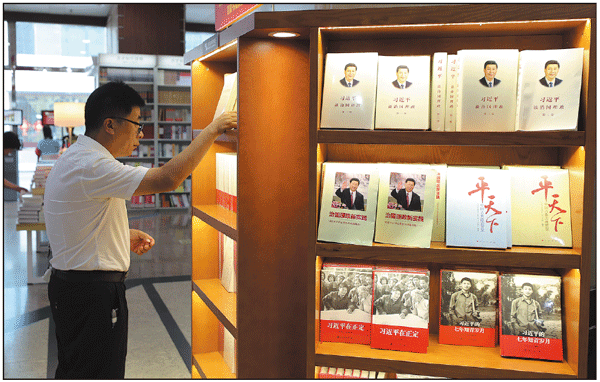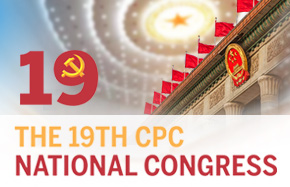Chapter and verse
Chinese publishing has come a long way in the past 70 years, Mei Jia reports.
Hu Kaimin, chief editor of the Foreign Languages Press, uses a "seven books" theory to summarize the publisher's achievements in presenting Chinese titles to global readers over the past 70 years.
The seven titles, each representing a decade, range from multilingual versions of late chairman Mao Zedong's collections in the 1960s to Chinese classics such as A Dream of Red Mansions in the 1970s, the Culture and Civilization of China series in the 1990s and the two-volume book, Xi Jinping: The Governance of China, sold in 32 editions in 28 languages so far.
"For the Xi book, we tried to launch both the Chinese and English versions almost simultaneously, closely followed by versions in languages recognized by the United Nations," Hu tells China Daily in his Beijing office. "We only managed to achieve this because of the progress Chinese publishing has made."
The company with perhaps the longest tradition of publishing and distributing Chinese books in the global market, China International Publishing Group, of which the Foreign Languages Press is a part, was set up in 1949, the same year the People's Republic of China was founded. It shows how, through continued effort, influential publishing has become in a country that has a long history of books.
According to officials from the General Administration of Press and Publication in 2011, in terms of volume and variety, China took the global lead in book and newspaper publishing in 2010, ranked second in digital publishing and third in printing based on total production value.
Fan Jun, deputy director of the Chinese Academy of Press and Publication, wrote in an article in Publishing Research that by 1956, China had 97 publishers, and published 129,000 titles in total in the seven years since 1950. The number of publishers by 2018, according to the National Press and Publication Administration's annual report released in August, was 585. They published 519,250 titles last year, including 247,108 new and 272,142 reprints.
And, it's not just about numbers.
Global recognition - the Nobel Prize for Mo Yan, the Hugo Award for Liu Cixin and the Hans Christian Andersen Award for Writing for Cao Wenxuan - reflects the rise of original storytelling in China.
Mao's works
In 1930, Mao wrote: "A single spark can start a prairie fire."
It all started with New China's first most circulated book: Selected Works of Mao Zedong (older translation Mao Tse-tung) and other works by Mao, including the Little Red Book of his quotes.
It wasn't until more recent times that foreign readers became familiar with only two Chinese names (also, as authors) - Confucius and Mao. That was partly due to the multilingual versions of Mao's books, published mainly by the Foreign Languages Press and distributed by the China International Book Trading Corp, also under the same group, with their foreign partners.
Late Zimbabwean president Robert Mugabe had said that during his years in prison, he abandoned many things but always kept a copy of Selected Works with him, He Mingxing, a Beijing Foreign Studies University professor, wrote in his book about Chinese books' overseas influence, published by Xinhua Press in 2014.
Mao's books established a positive image of a rising China, fostered friendships for New China and offered thoughts and experiences for Chinese titles to go on further, according to He.
Henry Noyes, descendent of the missionary Heiry Noyes, spent years publishing and distributing Chinese books and journals in the United States. Because of him, records show that the Little Red Book sold 2 million copies there. Born in Guangzhou in 1910, Noyes saw himself as an "overseas Chinese", and launched the China Books and Periodicals Inc in Chicago in 1960.
He spent months seeking permission to sell Chinese books and journals and traveled long distances to bring them to American households.
The two countries had not yet established diplomatic relations and the profits that Noyes had made from selling the books were frozen by his bank until 1979, when his Chinese partner finally received payments.
Classics to Panda series
After a pause of 16 years, Chinese publishers returned to the Frankfurt Book Fair in 1975 and gradually became important players in international copyright. The pause between the years also saw a scarcity of domestic publishing because of the "cultural revolution" (1966-76). New titles were few and far between, and the ones for the international market were almost nonexistent, Fan's article says.
In 1978, 35 types of classics, Chinese and foreign, were allowed to be reprinted in the country.
They included works by Mao Dun and Ba Jin, and also by William Shakespeare, Guy de Maupassant and Anton Chekov. Later, when the books were released, people lined up to buy them, and in Beijing alone 300,000 copies were sold.
The China International Publishing Group invited Yang Xianyi and his British wife Gladys Yang to work on a series of Chinese classics. After reform and opening-up started, besides the Red Mansions and other ancient classical texts, Yang Xianyi planned a range of books called the Panda series, much in the style of the Penguin series.
Wang Meng was among the writers to be introduced to English-language readers via the new series, together with Wang Anyi and their predecessors Lao She and Shen Congwen.
"They were in paperback and portable, and sold well. They were translated into other foreign languages from English," Hu, chief editor of the Foreign Languages Press, says.
The Panda series also told stories of people in the 1980s about their lives after the reform and openingup process began in a book called Beijing Residents: 100 Personal Accounts of Ordinary People. The book, titled Chinese Profiles in English, was a hit and was included in 421 overseas libraries, according to He, the Beijing professor.
"It was an early Chinese entry into the trendy nonfiction category of writing," he adds.
The Selected Works of Deng Xiaoping was published by the UK's Pergamon Press. More books were published in collaboration with foreign companies.
The bilingual series Library of Chinese Classics, a project started in 1994, marked the country's first attempt at systematically introducing Chinese culture to the world. The ongoing project involves more than 30 publishers with a total plan of 110 titles, covering ancient philosophy, history, literature, technology and military.
Data from Fan shows that in 1991, there were 465 publishers that presented 90,000 titles overall in China, respectively 6.2 times and 7 times more than in 1976.
For free or for sale
Foreigners know about kung fu, acupuncture and Chinese cuisine, but few read Chinese literature. This scenario continued into the first decade of the new millennium. Publishers in China were mostly cultural institutions by nature, not market players, and their chances of winning over global audiences were slim.
Jing Xiaomin, vice-president of the China Intercontinental Press, recalls her first experience at Book-Expo America in 1999. Visitors happily picked up posters of Chinese scenery from Jing and her colleagues but refused Chinese titles published by the company even when they were offered for free.
"I suppose the time was not right back then. Chinese books started to gain global appeal after 2005," Jing says.
Established in 1993, China Intercontinental Press sold its first copyright of the book Taoism in China in 2005.
"Before 2003, we published books in foreign languages known as nontrade publicity material. By joining the World Trade Organization in 2001, China got on the road to play a bigger role and attracted more attention," she adds.
In 2003, the country began to restructure its publishing industry, and turned old publishers into market-driven companies. Internationalization and global influence became part of the plan.
In 2006, the China Book International project was launched, followed by China Masterwork International. The two plans stressed the need for translation and promotion budgets, and left every other factor to market forces. Similar projects were launched by China's press and publication administrations, as well as the China Writers Association.
By then, the momentum for Chinese books to grow internationally had already picked up speed.
In 2007, Jing's company sold The Great Wall Revisited: From the Jade Gate to Old Dragon's Head by William Lindesay to Frances Lincoln Publishers in Britain and Harvard University Press. The book is a visual tour of 72 sets of photos in then-and-now comparisons, shot from 1871 to 2004 along the Great Wall.
"We made a fortune from that book, and set a new record," Jing adds.
Rising stars
With more new players joining the scene, Chinese titles gained a much wider global audience over the past decade. Chinese publishers have been exploring new and more effective ways in every aspect of producing and distributing international best-sellers.
Former US president Barack Obama enjoyed reading The Three-Body Problem by China's best known science-fiction author Liu, saying that it "was just wildly imaginative, really interesting", according to a New York Times interview.
The Three-Body trilogy extends from Earth's crisis from outer space to a distant future to the unimaginable scope of the universe's ultimate secrets. The first of the books has been described as one of the most influential Chinese novels, "winning Chinese literature much respect", professor He says.
Chen Feng from the China Educational Publications Import and Export Corp, which holds Liu's copyright, says the trilogy sold 1.6 million copies by September in 26 languages.
"It did best in the English and German markets," Chen says.
He Mingxing also cited 4,390 comments and reviews by Western media on the book by 2018.
Many believe Ken Liu's translations, himself a Hugo Award winning writer and translator, contributed to The Three-Body trilogy's popularity.
Before this, there were Wolf Totem, a novel by Jiang Rong, writings by Mo Yan and Yu Hua, and nonfiction works such as Confucius from the Heart: Ancient Wisdom for Today's World by Yu Dan, Keywords to Understand China, a compilation of works by different authors, and How the CPC Works by Xie Chuntao. Wolf Totem is the result of a legendary deal with Penguin, because of its theme of nature and best-selling success in China.
Mai Jia's works sold well in the Chinese market for years, but it is only in recent years that his detective and spy novels began to sell abroad, especially in English and Spanish.
His book Decoded was listed as a Penguin Classic alongside Lu Xun's works.
"Global success was quite accidental for me. There are a dozen other Chinese writers who write at this same level, I believe," Mai Jia says.
"The quality of translation really matters," he adds. "Writers need to keep the world in mind when they are creating, but the feelings and thoughts of being a Chinese writer should come out first."
External events have directly or indirectly led to the success of some Chinese books in recent years: China hosting the 2008 Olympics; the 2009 Frankfurt Book Fair where China was the "guest country"; China becoming the world's second-largest economy in 2010; and the Belt and Road Initiative that was launched in 2013.
Fan Jun with the Chinese Academy of Press and Publication said in an article that the BRI opened up new possibilities for Chinese books, with more markets, readers and publishers.
The Publishers Association of China in July announced an 86 percent growth through 7,100 deals by 2018 between Chinese publishers and countries involved in the BRI since 2016.
Liu Yehua of the Renmin University Press says the B&R Academic Publishing Alliance they initiated, a union of publishers, has attracted 310 publishers from 56 countries.
The rising demand is also seen in titles that explore Xi Jinping Thought on Socialism with Chinese Characteristics for a New Era, Liu says.
Jing from the Intercontinental Press says China's stable society is drawing attention abroad because "the Chinese development mode is attractive and people want to read more about it".
The press is also building up a digital platform called That's Books for Arabic readers and is extending the service to mobile phone apps.
Xi Jinping: The Governance of China has been in focus for the same reason.

"It's been like a golden key for many of our readers," Hu with the Foreign Languages Press says.
He says while working on the books, the company innovated ways of cooperating with foreign partners and held book talks and launches, reader meetings and symposiums in various countries.
"The best-selling Chinese titles are the ones that answer the global demand, and will give us the chance to cooperate further on new titles," Hu adds.
China is also the world's second-largest market for children's books.
For online literature, some English-language web novels are following the Chinese style and business models for intellectual property generated from writing and publishing.
In 2002, there was a big deficit in the copyright trade for publications, when the ratio of titles Chinese publishers imported and exported was 15 to 1, according to official data.
By 2011, the ratio was 2.1 to 1. Last year, China imported 16,829 titles from overseas markets and sold out 12,778.
Contact the writer at meijia@chinadaily.com.cn
|
A reader browses through books on a shelf at Wangfujing Bookstore in Beijing on Sept 27, including Xi Jinping: The Governance of China and Xi Jinping's Seven Years as an Educated Youth. Wang Jing / China Daily |
|
From left: Some books by influential Chinese writers-The Three-Body Problem by Liu Cixin; Red Sorghum by Mo Yan; Wolf Totem by Jiang Rong; and Decoded by Mai Jia. Photos provided to China Daily |
(China Daily Global 10/08/2019 page14)




















